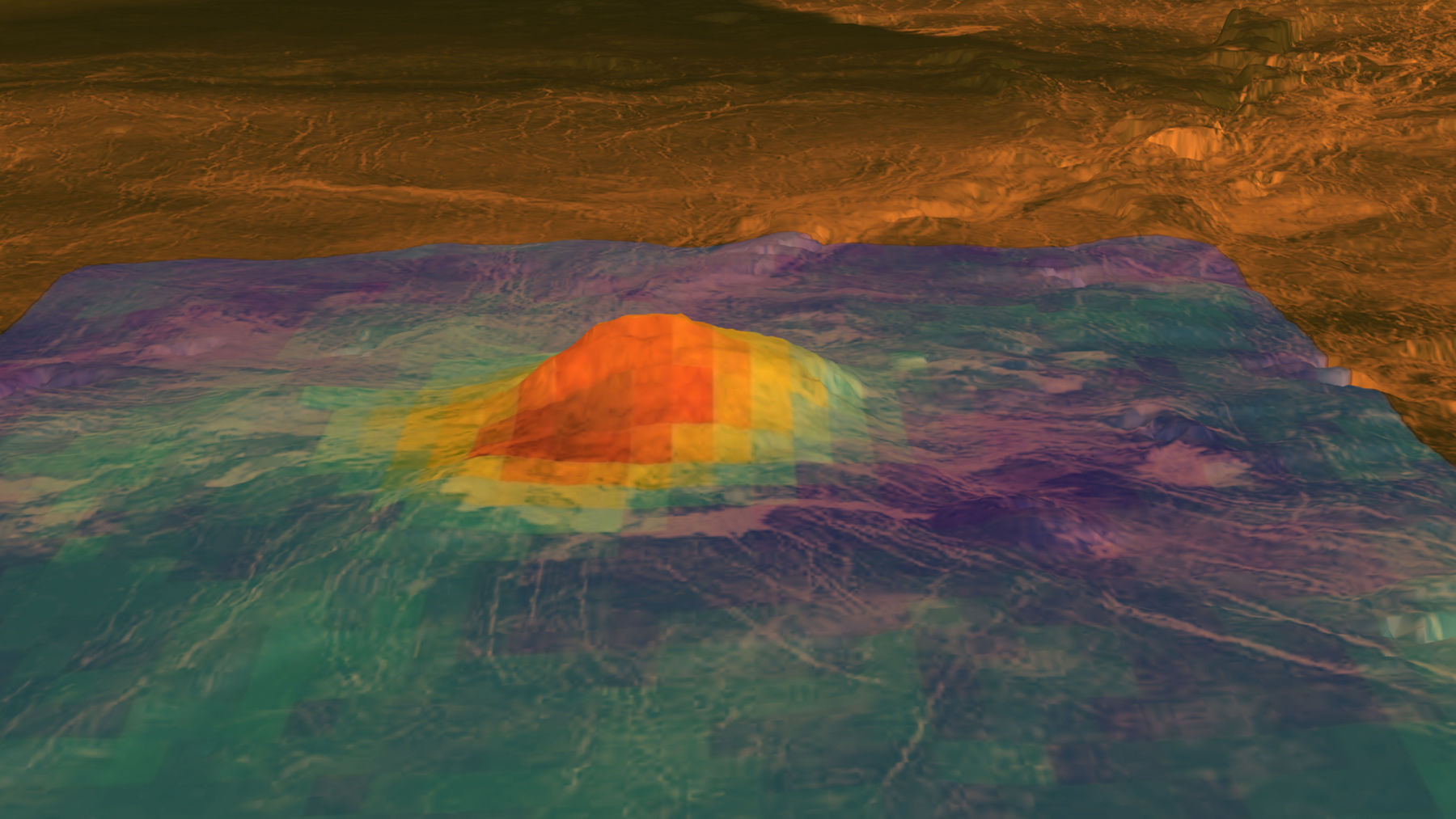Are volcanoes on Venus erupting right now? Like literally, *right now*?

Is Venus geologically active right now? Are volcanoes erupting on its surface even as you read this?
Maaaaaybe. The evidence has been growing for years now, but a new piece of research just published makes a compelling case that Venusian volcanoes have been belching out fresh lava in just the past few years.
Not "millions of years." Just "years." Wow!
We've known for some time that Venus has had an interesting past, geologically. The surface is covered in volcanoes; over 1,600 large ones have been found, more than on any other world in the solar system, and there may be a lot more smaller ones, hundreds of thousands of them! The surface is also covered in basalt, an igneous rock commonly spewed out of volcanoes. So it's clear that volcanically Venus has been jumpin' and jivin'. The question is when.
Then, just a few years ago, the peak of Idunn Mons, one of the largest Venusian volcanoes, was found to be warmer than the ground around it, implying it had magma in it. In 2010, evidence from the Venus Express mission showed that some lava flows looked relatively young (less than 2.5 million years). In 2006 Venus Express detected a sharp uptick in sulfur dioxide in the atmosphere of Venus, supporting the idea of current volcanic activity, and in 2015 that same mission spotted warm lava on the planet's surface in rift zones, cracks in the surface where volcanic activity is more likely.
So lots of observations support the idea that Venus has been volcanically active recently, and strongly hinted it may be ongoing. The new research takes a different tack: If lava on the surface of Venus were new, like really new, what would it look like chemically? And could that be observed from orbit?
Observations of Venus show that the mineral olivine is likely common in lava flows (just as it is on Earth). But here's a fun thing about Venus: The atmosphere is overwhelmingly composed of carbon dioxide (CO2), which is a greenhouse gas. So much heat is trapped by the atmosphere that the surface of Venus is at about 460°C (860°F)! At that temperature, olivine isn't stable; it oxidizes quickly (both in a CO2 dominated atmosphere and one with lots of O2 like Earth's). So the scientists took samples of olivine and exposed them to air at high temperatures to see what happened.
What they found is that at very high temperatures (900°C) the olivine changes very rapidly. Normally shiny and glassy, within minutes the olivine samples took on a dull appearance. Within hours they were coated in a reddish substance, which they identified spectroscopically as hematite and magnetite. At a lower temperature (600°C) the same thing happened, but it took much longer, weeks, and the process wasn't as complete. Some intact olivine could be seen under the coating.
OK, so what does this mean? Well, observations of lava flows on Venus from orbit are difficult, but have indicated that some unaltered olivine exists on the surface. But these new results show that unaltered olivine shouldn’t last very long there! At most, olivine should be able to exist for a few years before getting coated with hematite and magnetite. The fact that fresh olivine is seen means these lava flows must be younger than a few years… in other words, volcanoes erupted on Venus no more than a few years ago!
That's amazing.
There are some caveats, though. The test were done at temperatures higher than Venus, so it's not clear exactly how long unaltered olivine could hang around on Venus at the relatively low (ha!) temperature of 460°C. However, even if the process slows considerably at the cooler temps, it shows that the lava flows are still very young, much younger than 2.5 million year upper limit mentioned earlier. Even if they're, say, a century old, that's essentially now compared to the 4.56 billion year age of the planet (note too that on Earth we don't call a volcano extinct unless it hasn’t erupted in the past 10,000 years; one erupting 100 years ago would be considered at best dormant if not actually active).
Also, the tests were run under Earth air, which is different than Venusian air. I asked the lead author, Justin Filiberto, about this on Twitter:
He responded:
Ah, interesting! So under a carbon dioxide atmosphere they get similar reactions and reaction rates, strengthening their argument! They're also running more experiment with different varieties of basalt to see what happens, and again getting similar reactions and rates. Wow.
Why is this important? Well for one thing there aren't many active bodies in the solar system we know of. Earth, of course, and Jupiter's moon Io sport lots of volcanoes (though Io’s activity is due to different forces than Earth’s). Others have geysers of water shooting out (like Saturn's moon Enceladus) or nitrogen plumes (Triton, a moon of Neptune). Ceres has a cryovolcano, and Mars has volcanoes but as far as we now they've been extinct for billions of years. If Venus has active volcanoes, that adds to a very short list.
Also, Venus is in many ways like Earth. Similar size and mass, and even in chemical composition. But it's obviously also vastly different. Why? If we have another planet in the solar system with volcanoes, studying them gives us a huge amount of information to help us understand our own planet.
If this pans out, then it will also inform a potential next mission to Venus. As we understand the planet better, we can use that knowledge to figure out what we want to know next, and design the spacecraft accordingly*.
The atmosphere of Venus is so thick that the surface was entirely hidden from view until just a few decades ago, when we figured out how use radar and infrared mapping to pierce it (and in a handful of cases send landers to the surface). What we've discovered about our evil twin world jumped by huge amounts then… but there's still so much more to learn.
*I hope the next Venus mission is named Arboghast, as long as it includes a detector for protomolecule signatures.





























